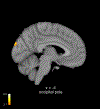Disentangling self from pain: mindfulness meditation-induced pain relief is driven by thalamic-default mode network decoupling
- PMID: 36095039
- PMCID: PMC9823141
- DOI: 10.1097/j.pain.0000000000002731
Disentangling self from pain: mindfulness meditation-induced pain relief is driven by thalamic-default mode network decoupling
Abstract
For millenniums, mindfulness was believed to diminish pain by reducing the influence of self-appraisals of noxious sensations. Today, mindfulness meditation is a highly popular and effective pain therapy that is believed to engage multiple, nonplacebo-related mechanisms to attenuate pain. Recent evidence suggests that mindfulness meditation-induced pain relief is associated with the engagement of unique cortico-thalamo-cortical nociceptive filtering mechanisms. However, the functional neural connections supporting mindfulness meditation-based analgesia remain unknown. This mechanistically focused clinical trial combined functional magnetic resonance imaging with psychophysical pain testing (49°C stimulation and pain visual analogue scales) to identify the neural connectivity supporting the direct modulation of pain-related behavioral and neural responses by mindfulness meditation. We hypothesized that mindfulness meditation-based pain relief would be reflected by greater decoupling between brain mechanisms supporting appraisal (prefrontal) and nociceptive processing (thalamus). After baseline pain testing, 40 participants were randomized to a well-validated, 4-session mindfulness meditation or book-listening regimen. Functional magnetic resonance imaging and noxious heat (49°C; right calf) were combined during meditation to test study hypotheses. Mindfulness meditation significantly reduced behavioral and neural pain responses when compared to the controls. Preregistered (NCT03414138) whole-brain analyses revealed that mindfulness meditation-induced analgesia was moderated by greater thalamus-precuneus decoupling and ventromedial prefrontal deactivation, respectively, signifying a pain modulatory role across functionally distinct neural mechanisms supporting self-referential processing. Two separate preregistered seed-to-seed analyses found that mindfulness meditation-based pain relief was also associated with weaker contralateral thalamic connectivity with the prefrontal and primary somatosensory cortex, respectively. Thus, we propose that mindfulness meditation is associated with a novel self-referential nociceptive gating mechanism to reduce pain.
Copyright © 2022 International Association for the Study of Pain.
Conflict of interest statement
DECLARATION OF INTERESTS
The authors declare no competing interests.
Figures









References
-
- Akselrod M, Martuzzi R, Serino A, van der Zwaag W, Gassert R, Blanke O. Anatomical and functional properties of the foot and leg representation in areas 3b, 1 and 2 of primary somatosensory cortex in humans: A 7T fMRI study. Neuroimage 2017;159:473–487. - PubMed
-
- Blanke O, Slater M, Serino A. Behavioral, Neural, and Computational Principles of Bodily Self-Consciousness. Neuron 2015;88(1):145–166. - PubMed

